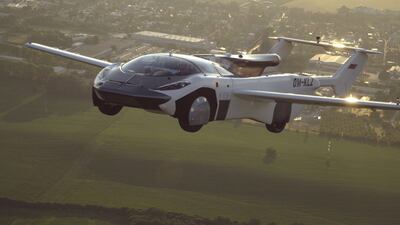A flying car that took 20 years to be developed has been declared airworthy in Europe.
The AirCar, a two-seat, dual-mode car-aircraft vehicle powered by a 1.6-litre BMW engine, completed 70 hours of rigorous flight testing compatible with European Aviation Safety Agency standards.
The tests, by the Slovak Transport Authority, included more than 200 take-offs and landings, covered the full range of flight and performance manoeuvres and demonstrated static and dynamic stability in the aircraft mode.
Take-off and landing were achieved even without the pilot’s need to touch the flight controls. The vehicle needs 300 metres to take off.
The AirCar's wings fold and retract when it is on the road, enabling the vehicle to fit into a normal parking space. Other technology includes a parachute system and a folding tail.
Able to reach an altitude of 8,000 feet and reach speeds of more than 160kph, the vehicle weighs 1,100 kilograms and can carry a load of 200kg.
The AirCar made its first flight six months ago in Bratislava, Slovakia. During the test, the vehicle took three minutes to switch from plane to car mode and was driven into the city centre.

Developer KleinVision has yet to announce its price.
The company says the folding tail surfaces contribute to a better longitudinal stability and take-off characteristics, as in a conventional aircraft.
It plans to change the interior and to introduce three and four-seaters, twin-engine and amphibious models.
“AirCar certification opens the door for mass production of very efficient flying cars. It is official and the final confirmation of our ability to change mid-distance travel forever,” said Stefan Klein, the inventor and test pilot, who led the development team.
Mr Klein has undertaken research projects for Audi, Volkswagen and BMW, among other marques, and in 2005 he was appointed a visiting professor at Glasgow School of Art.

He graduated from Slovak University of Technology in 1983 and gained a master's degree from the Academy of Fine Arts and Design, also in Bratislava. He also studied industrial design at l’Ecole des Beaux Arts et Design, Saint Etienne, France.
“50 years ago, the car was the epitome of freedom,” says Anton Zajac, the project cofounder. “AirCar expands those frontiers, by taking us into the next dimension; where road meets sky.
“With Aircar you will arrive at your destination without the hassle of getting a ride to airport and passing through commercial security, you can drive your AirCar to the golf course, the office, the mall or your hotel and park it in a normal parking space."
After AirCar’s first intercity flight last year, Dr Branko Sarh, senior technical fellow at Boeing, said: “The automated transition from road vehicle into an air vehicle and vice versa, deploying/retracting wings and tail is not only the result of pioneering enthusiasm, innovative spirit and courage ,it is an outcome of excellent engineering and professional knowledge.”
Rene Molnar, the director of the Civil Aviation Division at the Transport Authority of Slovakia, said: “Transportation Authority carefully monitored all stages of AirCar development from its start in 2017. The transportation safety is our highest priority.”





